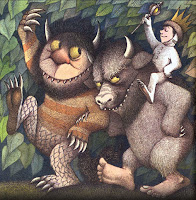
by Maurice Sendak
ALA Notable Children's Book 1963
Caldecott Award 1964
Summary
Where the Wild Things Are chronicles one night in Max's life. The story begins with Max traipsing about his house in a wolf suit, making "mischief of one kind and another." Max's disturbance of his house gets him sent to his room to go to bed without supper. As Max closes his eyes while still standing, a forest grew in his room "until his ceiling hung with vines and the walls became the world all around." An ocean came by and picked Max up, and he sailed for over a year until he reached the place where the wild things are. When he got there, the wild things "roared their terrible roars and gnashed their terrible teeth and rolled their terrible eyes and showed their terrible claws." Max, however, was able to control them by staring into their eyes without blinking, and they made him king of all the wild things. For a few pages the wild things and Max have a wild rumpus, which is filled with full page illustrations of them playing on the island. Soon, however, Max becomes lonely and "wanted to be where someone loved him best of all." He smelled good things to eat and decided to give up being king of the wild things. He sailed back home, and upon arriving he found that it was the same night and his dinner was waiting for him. "And it was still hot."
Discussion
Where the Wild Things Are is a world renowned children's book for the imagination that it provokes in children. It is said that children's imaginations run away with them, and this book is the example of one child with a large imagination, that was able to believe he traveled away while angry and became king of the wild things. When I read this book as a child, I always imagined that my brother would become king of the wild things, and then I would have my own peace and quiet. When reading this book to very young children, I have found that they especially like to gnash their teeth and roar with the wild things, as those descriptive words allow for actions along with the book. Where the Wild Things Are could easily be used within a classroom, as well as a bedtime story at home. This week the theme in the preschool that I have been observing at is monsters, and this book is a favorite in the classroom.
As Children's Literature, Briefly states, "good fantasy actually tells the truth about life. It clarifies the human condition and captures the essence of our deepest emotions, dreams, hopes, and fears. If fantasy does not do these things, it fails." Where the Wild Things Are has the great ability to do all of this and more. Max's escape from his punishment allows children to imagine an easy escape and use their imagination to escape their lives. This is a common tool children with difficult childhoods use, as well as all children when they are merely upset with what is going on in their life. However, the story explains to children that even if they were able to go and rule their own colony of wild things, the pull of reality will reach them. It explains the importance of family and love, and that the feeling of being loved is one of the most powerful emotions in the world. No child likes to be lonely, which makes Max's return understandable, and it allows the book to end nicely. Where the Wild Things Are can relate to all children, as well as adults, in that everyone has had feelings of loneliness or a desire to escape their life and be in control in a wholly new place. Although Max is white, I don't believe that this boo marginalizes any one group, as everyone can relate to Max's feelings.
Application
There are hundreds of created lesson plans for PreK-2nd classrooms related to Where the Wild Things Are. A few links are posted to some of the better lesson plans.
This is a lesson plan for a Kindergarten classroom, going through the whole story and pulling out lessons across a variety of learning domains: http://www.easyfunschool.com/article1293.html
Sendak, M. (1988). Where the Wild Things Are. New York: HarperCollins.

Super nice discussion and evaluation, Sarah. I enjoyed how attractive the entry is, the way you organized it, and the link you've provided to an online version of the story. Nice job!
ReplyDelete